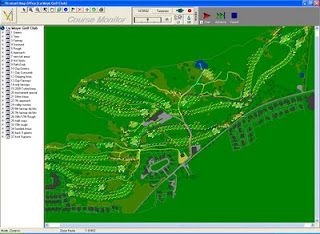Following the chemical control to the 4th and 6th greens on the 8th October, I am pleased to report that the product applied is working! The broadleaved Rye and Yorkshire Fog grasses, which were targeted with the chemical, are now in serious decline causing a number of bare areas and a general reduction in sward density. Seeding and top dressing of the two greens in question has taken place and recovery of the surfaces is underway.
Bunker Refurbishments
Bunker Refurbishments
Work on rebuilding some of the most worn out bunker faces has progressed well with the bunkers by the 15th green and the two bunkers nearest the 11th green now complete. . The bunkers on the 15th were last rebuilt in 2007 meaning they have only lasted two seasons. This is the absolute minimum amount of time we would expect a bunker face to last and thankfully most bunkers on the course will last much longer than this. A variety of factors influence the length of time a revetted bunker will last, these include; the frequency visited by players, the quality of the turf used in the construction and the position of the bunker in relation to the sun.
Aerating The Turf
Aeration is one of the most important maintenance tasks carried out on turf. The word aeration means quite simply to get air into something. In turf it is simply the production of holes through the turf surface into the underlying rootzone (soil) to allow gases (oxygen etc.) in and out of the soil and for water and grass roots to move down through the soil.
Since the middle of October we have been running two verti-drain type machines over all areas of the course. Fairways and high wear walkways were tackled first, followed by greens and their surrounds. These machines allow us to make lots of holes in the turf and at sufficient depth to enable the movement of water more quickly through the soil beneath. The action of these particular machines also allows a certain amount of "heave" to be put on the soil. This lifts the level of the ground slightly allowing air and moisture to penetrate and relieve compacted areas. Compaction in the turf is caused by the regular movement of people or machinery over an area, wet soils compact more easily as the water in the soil acts as a lubricant allowing the particles to slide closer together and form a bond. Our clay soils on holes 10-13 are particularly prone to compaction.
All greens and surrounds will be verti-drained again in February and thereafter every October and February.
Chipping Area Redesign
Work will start soon on the redesign of the chipping area. We plan to construct a large central green which will facilitate a wide range of short chip shots. The intention is to maintain this green to a higher standard than the existing chipping greens, enabling the shots to roll out in a way that is similar to the main greens on the course. This higher standard of green can only be maintained if players use the green in the intended way - only for short chip shots. If players decide to ignore this and play longer shots to the new green it will quickly deteriorate to a level similar to that of the chipping greens now. The new green is to practice short chip shots only. A separate area will be constructed next to the new green to allow longer shots to be played into a designated target area. The area will allow shots of up to 70yds to be played. Finally, one of the existing greens will have two new bunkers added to create a dedicated bunker practice area This redesign aims to make the most of the relatively small space our chipping area offers for practice.



















